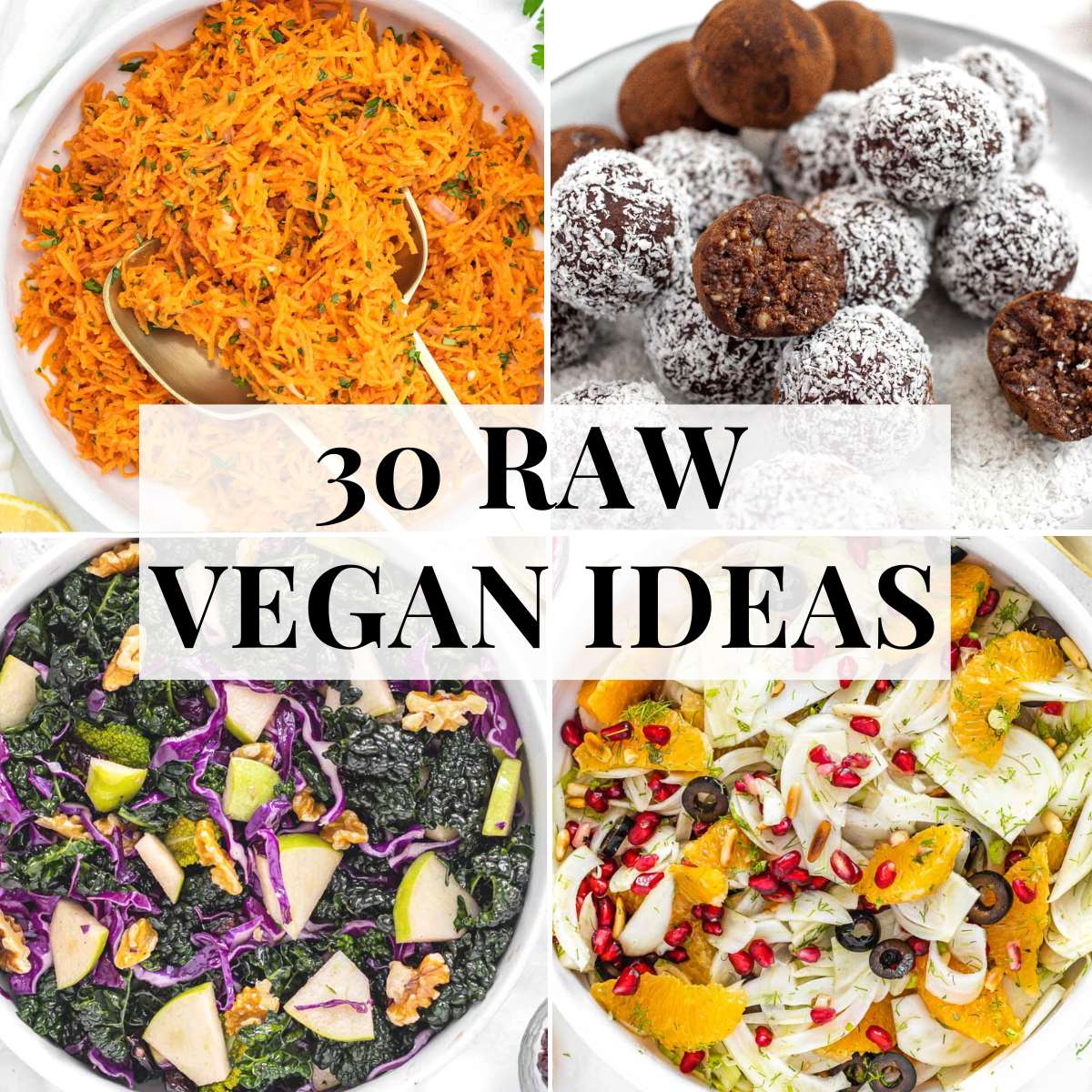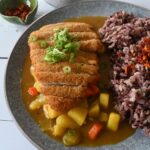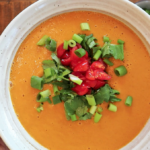Tired of raw vegan meals leaving you hungry and unsatisfied? Discover the secret to creating vibrant, flavorful, and truly fulfilling raw vegan dishes that nourish your body and delight your taste buds. This guide unveils the key principles of crafting satisfying raw vegan meals, from mastering macronutrient balance to exploring diverse preparation techniques and innovative recipe ideas. Prepare to embark on a culinary journey that redefines your perception of raw vegan cuisine.
We’ll explore the essential role of healthy fats and protein in achieving satiety, providing practical strategies for incorporating them seamlessly into your meals. Learn to create creamy sauces, vibrant salads, and satisfying main courses that are both delicious and nutritionally complete. We’ll also tackle common challenges, offering solutions to overcome cravings and maintain a balanced raw vegan diet, even with a busy lifestyle. Get ready to transform your raw vegan experience!
Satisfying Raw Vegan Meal Foundations
Creating truly satisfying raw vegan meals requires a strategic approach to macronutrient balance. Ignoring the body’s need for healthy fats and sufficient protein often leads to feelings of hunger and low energy, undermining the benefits of a plant-based diet. Understanding how to incorporate these essential nutrients is key to experiencing the sustained energy and satisfaction a raw vegan lifestyle can offer.
The Importance of Healthy Fats for Satiety
Healthy fats are crucial for satiety in a raw vegan diet. Unlike refined carbohydrates, which can lead to rapid blood sugar spikes and subsequent crashes, healthy fats digest slowly, promoting a feeling of fullness and sustained energy. These fats also play a vital role in hormone production and nutrient absorption, further contributing to overall well-being. The creamy texture of many healthy fats also adds a richness and satisfying mouthfeel to raw vegan dishes, enhancing their appeal.
Five Versatile Raw Vegan Ingredients Promoting Fullness
Several raw vegan ingredients are particularly effective at promoting fullness due to their fiber content, water content, or combination of nutrients.
- Avocados: Rich in healthy monounsaturated fats and fiber, avocados add creaminess and satiety to smoothies, salads, and dips.
- Chia Seeds: These tiny powerhouses absorb liquid, expanding in the stomach and creating a feeling of fullness. They are easily incorporated into smoothies, puddings, or sprinkled on salads.
- Hemp Seeds: A complete protein source, hemp seeds also provide healthy fats and fiber, contributing to sustained energy and satiety. They offer a slightly nutty flavor and can be added to various dishes.
- Raw Nuts and Seeds (e.g., almonds, walnuts, pumpkin seeds): These provide healthy fats, protein, and fiber. Their satisfying crunch adds texture to meals.
- Leafy Greens (e.g., spinach, kale, romaine lettuce): High in fiber and water, leafy greens add volume to meals without adding many calories, promoting a feeling of fullness.
Creative Ways to Incorporate Protein into Raw Vegan Meals
Protein is essential for sustained energy and muscle maintenance. While many raw vegan foods contain protein, creatively incorporating it ensures adequate intake.
- Nut and Seed Butters: These creamy spreads are a convenient way to add protein and healthy fats to smoothies, raw desserts, or as a dip with vegetables.
- Sprouted Seeds and Nuts: Sprouting increases the bioavailability of nutrients, including protein, making them easier to digest and more readily available to the body. Sprouted seeds and nuts can be added to salads or eaten as a snack.
- Raw Vegan Protein Powders: Derived from sources like pea protein, brown rice protein, or sunflower seed protein, these powders can be added to smoothies or used in raw vegan baking for a protein boost.
Sample Satisfying Raw Vegan Meal Plan
This sample meal plan demonstrates a balanced approach to macronutrients, ensuring satiety and sustained energy throughout the day. Individual needs may vary, so adjust portion sizes according to your activity level and caloric needs.
| Meal | Description | Macronutrient Focus |
|---|---|---|
| Breakfast | Smoothie with avocado, spinach, chia seeds, hemp seeds, and almond milk. | Healthy fats, protein, fiber |
| Lunch | Large salad with mixed greens, sprouted sunflower seeds, avocado slices, and a lemon-tahini dressing. | Healthy fats, protein, fiber |
| Dinner | Zucchini noodles with a walnut pesto sauce, topped with chopped tomatoes and raw almonds. | Healthy fats, protein, fiber |
| Snacks | Handful of almonds, raw vegetables with hummus, or a small bowl of fruit. | Healthy fats, protein, fiber |
Mastering Raw Vegan Meal Preparation Techniques
Creating delicious and satisfying raw vegan meals goes beyond simply assembling ingredients; it’s about mastering techniques that unlock vibrant flavors and textures. This section will guide you through essential preparation methods, from crafting vibrant salads to creating creamy sauces and building hearty main courses. Understanding these techniques will elevate your raw vegan culinary experience.
Vibrant Raw Vegan Salad Preparation
Preparing a vibrant raw vegan salad involves a careful selection of colorful ingredients and a thoughtfully crafted dressing. Begin by choosing a variety of textures and colors. Imagine a base of crisp romaine lettuce, punctuated by the deep orange of shredded carrots, the vibrant purple of thinly sliced red cabbage, and the bright green of finely chopped cucumber. Adding a handful of sunflower seeds provides a satisfying crunch. For the dressing, consider a simple yet effective blend of lemon juice, extra virgin olive oil, a touch of maple syrup for sweetness, and a pinch of sea salt. Whisk these ingredients together until emulsified, creating a light and flavorful dressing that coats the salad beautifully. The final step is to gently toss the ingredients together, ensuring each piece is lightly dressed without being soggy. The result is a visually appealing and incredibly flavorful salad, bursting with freshness.
Creating Creamy Raw Vegan Sauces and Dips
The key to creamy raw vegan sauces and dips lies in the use of healthy fats and blending techniques. Avocados form the base of many creamy sauces, their rich texture lending itself beautifully to blending. Imagine a vibrant green avocado base, blended with lime juice for tanginess, cilantro for freshness, and a touch of jalapeño for a subtle kick. This mixture, when blended until completely smooth and creamy, creates a vibrant guacamole. Alternatively, a cashew-based cream can be created by soaking raw cashews in water for at least four hours, then blending them with water until smooth and creamy. This base can then be adapted to various flavors. For example, adding sun-dried tomatoes and balsamic vinegar creates a rich and tangy sauce, while adding roasted red peppers and garlic results in a sweeter, more savory dip. The possibilities are endless, allowing for creative exploration of flavors and textures.
Satisfying Raw Vegan Main Course Recipe
This recipe showcases a satisfying raw vegan main course featuring a unique combination of vegetables and nuts. We’ll create a hearty “zoodle” (zucchini noodle) bowl topped with a vibrant walnut “meat” and a creamy avocado dressing. First, spiralize zucchini into noodles. For the walnut “meat,” pulse raw walnuts in a food processor until they resemble a coarse crumble. Then, combine the walnut crumble with finely chopped sun-dried tomatoes, nutritional yeast for a cheesy flavor, and herbs like oregano and thyme. This mixture provides a hearty and satisfying protein source. To create the creamy avocado dressing, simply blend ripe avocados with lime juice, water, and a touch of salt until smooth and creamy. Finally, layer the zucchini noodles in a bowl, top with the walnut “meat” mixture, and drizzle generously with the avocado dressing. This dish provides a balance of textures and flavors, creating a fulfilling and healthy raw vegan meal.
Dehydrating Raw Vegan Foods: A Comparison
| Method | Time | Equipment | Advantages/Disadvantages |
|---|---|---|---|
| Food Dehydrator | 8-24 hours (depending on food and thickness) | Food dehydrator with adjustable temperature settings | Advantages: Even drying, consistent results. Disadvantages: Can be expensive, takes up counter space. |
| Oven Dehydration | 4-12 hours (low temperature, door ajar) | Oven with low temperature setting | Advantages: Most kitchens already have an oven. Disadvantages: Requires close monitoring, uneven drying possible. |
| Sun Drying | 2-7 days (depending on weather and food) | Screen or tray, sunny location | Advantages: Free, utilizes natural energy. Disadvantages: Highly dependent on weather, risk of spoilage or insect contamination. |
| Freeze Drying | 12-48 hours | Freeze dryer | Advantages: Preserves nutrients and flavor exceptionally well. Disadvantages: Very expensive equipment, not practical for home use. |
Recipe Showcase

This recipe showcases a vibrant and satisfying raw vegan meal, perfect for a light lunch or a refreshing dinner. It combines the creamy richness of avocado with the sweetness of mango and the satisfying crunch of sunflower seeds, all while remaining completely raw and packed with nutrients. This meal is easy to prepare, requiring minimal equipment and time, making it ideal for busy weeknights or a relaxed weekend brunch. The balanced blend of healthy fats, carbohydrates, and protein ensures sustained energy and satiety.
Zesty Mango Avocado Salad with Sunflower Seed Crunch
This zesty salad is a delightful combination of textures and flavors, showcasing the versatility of raw ingredients. The creamy avocado pairs beautifully with the sweet mango, while the sunflower seeds add a satisfying crunch. A simple lime dressing brightens the whole dish, creating a refreshing and energizing meal.
Ingredients
- 1 ripe avocado, diced
- 1 ripe mango, diced
- 1/2 cup sunflower seeds
- 1/4 cup red onion, finely chopped
- 1/4 cup cilantro, chopped
- Juice of 1 lime
- Pinch of sea salt
- Pinch of black pepper
Preparation
This recipe is remarkably simple and requires minimal preparation. The focus is on combining fresh, high-quality ingredients to create a vibrant and flavorful meal.
- Gently dice the avocado and mango into bite-sized pieces. Avoid over-mixing to preserve their texture.
- In a medium bowl, combine the diced avocado and mango.
- Add the chopped red onion and cilantro. The red onion provides a pleasant sharpness that complements the sweetness of the mango.
- Sprinkle the sunflower seeds over the mixture. The seeds add a delightful crunch and a boost of healthy fats.
- In a small bowl, whisk together the lime juice, salt, and pepper. The lime juice brightens the flavors and adds a refreshing tang.
- Drizzle the lime dressing over the salad and gently toss to combine. Avoid over-mixing to prevent the avocado from becoming mushy.
Nutritional Information (per serving, approximate)
This nutritional information is an estimate and may vary based on the specific ingredients used. It provides a general idea of the nutritional profile of this refreshing raw vegan meal.
| Nutrient | Amount |
|---|---|
| Calories | 300-350 |
| Fat | 20-25g |
| Carbohydrates | 25-30g |
| Protein | 5-7g |
| Fiber | 10-12g |
Creating satisfying raw vegan meals is not about deprivation, but about embracing a vibrant and fulfilling culinary adventure. By understanding the importance of macronutrient balance, mastering essential preparation techniques, and exploring a diverse range of recipes, you can unlock the true potential of raw vegan cuisine. This guide has equipped you with the knowledge and inspiration to craft delicious, energizing meals that nourish your body and satisfy your soul. So, embrace the vibrant colors, fresh flavors, and satisfying textures of a truly fulfilling raw vegan lifestyle.
Questions and Answers
What are the best tools for preparing raw vegan meals?
High-quality blenders, food processors, and dehydrators are invaluable. A good knife set is also essential for precise vegetable preparation.
How do I store raw vegan meals to maintain freshness and nutrients?
Proper storage is crucial. Use airtight containers and store meals in the refrigerator or freezer, depending on the recipe. Consume within a few days for optimal freshness.
Can I make raw vegan meals ahead of time for busy weekdays?
Absolutely! Many raw vegan meals can be prepped in advance. Prepare components like sauces and chopped vegetables on the weekend for quick assembly during the week.
Are raw vegan meals suitable for athletes or those with high energy demands?
Yes, with careful planning. Prioritize meals rich in healthy fats and protein to ensure sufficient energy levels. Consider adding nutrient-dense supplements as needed.


